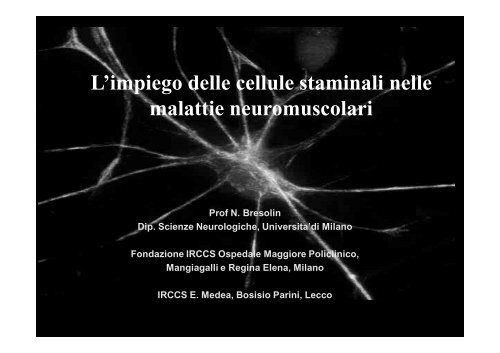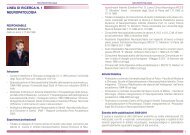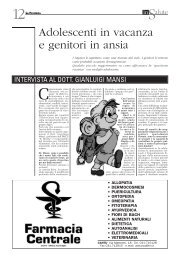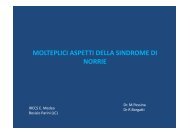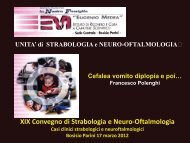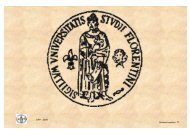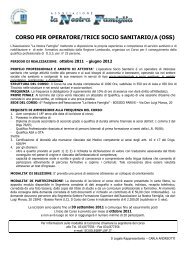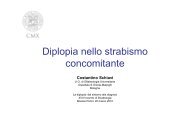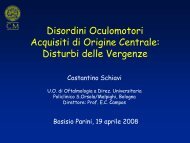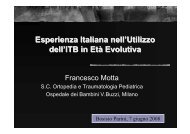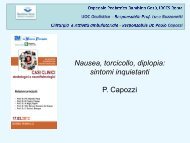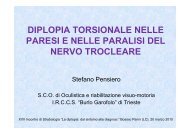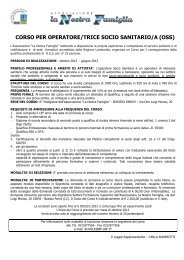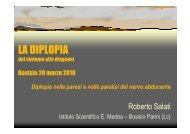N. Bresolin - E. Medea
N. Bresolin - E. Medea
N. Bresolin - E. Medea
You also want an ePaper? Increase the reach of your titles
YUMPU automatically turns print PDFs into web optimized ePapers that Google loves.
L’impiego delle cellule staminali nelle<br />
malattie neuromuscolari<br />
Prof N. <strong>Bresolin</strong><br />
Dip. Scienze Neurologiche, Universita’di Milano<br />
Fondazione IRCCS Ospedale Maggiore Policlinico,<br />
Mangiagalli e Regina Elena, Milano<br />
IRCCS E. <strong>Medea</strong>, Bosisio Parini, Lecco
Cell transplantation and replacement<br />
GLIAL<br />
degeneration<br />
Demyelinating disease<br />
GLOBAL<br />
Degeneration<br />
Trauma and stroke<br />
Cognitive and Physical<br />
rehabilitation<br />
Neurodegenerative<br />
Neuromuscular<br />
Diseases<br />
Neural Stem cell therapy<br />
NEURONAL<br />
Degeneration<br />
Paracrine systems (PD)<br />
SELECTIVE<br />
Degeneration<br />
ALS, HD, Ataxias,<br />
FSH,DMD,LG etc<br />
Neuroprotective Therapies
Cellule staminali<br />
• Capacità di autorinnovarsi<br />
• Dare origine a cellule differenziate
Zigote<br />
STEM CELLS CONTINUUM<br />
Totipotent<br />
stem cells<br />
Embryonic<br />
stem cells<br />
Pluripotent<br />
stem cells<br />
Somatic<br />
stem cells<br />
Bone<br />
marrow, skin<br />
muscle etc<br />
stem cells
Blood<br />
blood cells<br />
Vessels<br />
endothelial cells<br />
Heart<br />
cardiomyocytes<br />
Le cellule staminali danno origine<br />
a cellule differenziate<br />
Bone<br />
Kidney osteoblasts<br />
Skin<br />
Muscle<br />
Pancreas<br />
Nervous<br />
System<br />
neurons<br />
astrocytes<br />
oligodendrocytes<br />
Liver<br />
insulin producing cells<br />
liver cells
Reprogramming of somatic stem cells<br />
Human Fibroblasts Induced pluripotent<br />
stem cells (iPS)<br />
Teratoma derived from human iPS cells<br />
Injected in SCID mice
In vitro differentiation of iPS.<br />
In vivo engraftment<br />
iPS cell-derived neurons integrate into<br />
the striatum of hemiparkinsonian<br />
rats and improve behavioral deficits.
Le cellule staminali possono avere effetti<br />
terapeutici attraverso diversi meccanismi<br />
Neuroprotezione Sostituzione cellulare<br />
Produzione di molecole con effetto<br />
neurotrofico, antiinfiammatorio,<br />
vasogenico etc.<br />
Geneticamente modificate per<br />
produrre specifici fattori<br />
Genesi di:<br />
•Nuovi neuroni<br />
•Glia
SVZ<br />
Isolation<br />
Astrocytes<br />
SVZ<br />
MATURE CELLS<br />
Neurons<br />
Corti et al<br />
Cellule staminali neurali<br />
Dissociate<br />
Oligodendrocytes<br />
EGF/FGF-2<br />
SELF-RENEWAL<br />
EGF/FGF-2
Cellule staminali neuronali CD133 positive si<br />
integrano in vivo nella corteccia<br />
Corti et al.2007
Multipotentiali<br />
Multipotentiality, ty, homing properties and pyramidal neurogenesis of CNS CNS-derived derived<br />
LeX(ssea LeX(ssea-1)+/CXCR4+ 1)+/CXCR4+ stem cells<br />
Isolamento di una<br />
sottofrazione<br />
staminale con<br />
doppia positività<br />
per LeX(Le) e<br />
CXCR4(CX) che<br />
possiede elevato<br />
potenziale di<br />
homing nel SNC<br />
ed estesa capacità<br />
di engraftement<br />
S. Corti, FASEB J. 2005 Nov;19(13):1860<br />
Nov;19(13):1860-2
Isolamento di una sottofrazione cellulare Le+CX+<br />
Adult<br />
murine brain<br />
Neurospheres<br />
MACS selection for<br />
LeX followed by<br />
FACS selection for<br />
LeX+CXCR4+<br />
SVZ<br />
Evaluation of<br />
Self Self-renewal renewal<br />
Differentation<br />
Phase Phase/DAPI DAPI LeX LeX/CXCR4 CXCR4<br />
Phase Phase/DAPI DAPI<br />
LeX CXCR4<br />
LeX LeX/CXCR4 CXCR4
Il trapianto di cellule staminali Le+CX+ si integra in<br />
corteccia e ricostituisce i circuiti neuronali in un<br />
modello ischemico murino<br />
Corti et al.2007
Trapianto di cellule staminali<br />
nelle malattie neuromuscolari:<br />
le distrofie muscolari
Distrofia Muscolare<br />
di Duchenne<br />
E’ una malattia geneticamente<br />
determinata X-linked dovuta all’assenza<br />
di distrofina<br />
•E’ caratterizzata da distrofia muscolare<br />
progressiva con ipostenia muscolare<br />
ingravescente e perdita della<br />
deambulazione intorno a 12 anni.
Il trapianto di cellule staminali puo’<br />
contribuire alla rigenerazione del<br />
tessuto muscolare scheletrico
Il nostro obiettivo: trapiantare le cellule<br />
muscolari attraverso la circolazione sanguigna<br />
Injected MSCs<br />
Muscle progenitors<br />
Rescue of muscular dystrophy
Isolation of muscle-derived stem cells<br />
(MDSCs).<br />
Density gradient separation<br />
Magnetic labeling using<br />
Sca-1/CD34 microbeads<br />
Separation with MACS<br />
column type LS<br />
Elution of<br />
highly pure MDSCs
Muscle homing of the Sca-1+/CD34-MDSCs after<br />
i.m. transplantation of mdx mice<br />
Pectoralis<br />
Quadriceps
Sca-1+/CD34- MDSCs express the L-selectin<br />
adhesion molecules
Myogenic differentiation of<br />
Sca-1+/CD34-/L-selectin+ MDSCs<br />
after i.v. injection of mdx mice
Delivery of stem cells to muscle fibers via<br />
intra-venous injection<br />
Two months-old mdx One year-old mdx
TRAP assay<br />
Clonogenic, self-renewal and multi-potency<br />
of AC133 positive cells from blood<br />
VEGF<br />
CFU-C assay in methyl<br />
cellulose
Expression of muscle markers by CD133 positive cells<br />
derived from the blood tissues.<br />
AC133+<br />
MyHC GFP Merge
Double-blinded randomized clinical trial phase I: autologous<br />
transplantation of muscle-derived AC133+ cells in Duchenne<br />
Muscular Dystrophy.<br />
Eight DMD patients were included in this study and randomized into two<br />
groups:<br />
Group A (n=5; subjects 003-004-005-006-007)<br />
AC133+cells injection into left abductor digiti minimi muscles (ADM)<br />
Group B (n=3 subjects 008-009-010)<br />
saline solution injection into ADM<br />
Primary outcome: Tolerance and feasibility of intramuscular<br />
transplantation of AC133+ cells to always ensure first, the<br />
patient’s safety and well-being, while aiming towards a treatment.<br />
Secondary outcome: muscular strength tests by MVIC and muscle<br />
force analysis skinned myofibers.<br />
Torrente Y et al. Cell Transplantation 2007
Autologous transplantation of muscle-derived AC133+<br />
cells<br />
Tibialis Anterior muscle (1gr)<br />
Muscle dissotiation LIBERASE Hi<br />
Left abductor digiti minimi muscle (ADM)<br />
Quality control,<br />
microbiology<br />
Myofibers Injections of 20X103AC133+ cells<br />
*15ml Hamilton with a 27-G needle<br />
Injection site<br />
•RPMI +<br />
In vitro serum free<br />
culture for 48h<br />
•human albumin 20%+<br />
•human insulin 100 Ul/m<br />
*5ml of cell suspension delivered in<br />
each injection<br />
*Injection depth 0.5 cm,interinjection<br />
distances 1mm (sterile<br />
transparent grid)
Local side effects after intramuscular transplantation of<br />
muscle-derived AC133+ cells<br />
Treated Controlateral<br />
6<br />
5<br />
4<br />
3<br />
2<br />
1<br />
0<br />
2004-<br />
003<br />
2004-<br />
004<br />
2004-<br />
005<br />
2004-<br />
006<br />
2004-<br />
007<br />
2004-<br />
008<br />
2004-<br />
009<br />
2004-<br />
010
Single muscle fibre strenght increase in<br />
DMD patients<br />
after AC133+ local injection<br />
CD133+/CXCR4+/CD34+<br />
Torrente Y et al. Cell Transplantation 2007<br />
0003C 0003T<br />
Slow Myofibers<br />
Fast Myofibers<br />
CD31 vessels
Intra-arterial delivery of wild-type<br />
mesoangioblasts<br />
in alpha-SG null mice<br />
i.a.<br />
α-SG KO
Expression of alpha-SG in alpha-SG null mice<br />
after intra-arterial delivery of wild-type<br />
mesoangioblasts<br />
Sampaolesi et al. Science 2003;301(5632):487-92
Expression of α-SG and dystrophin related proteins<br />
in α-SG null mice after intra-arterial delivery of<br />
wild-type mesangioblasts<br />
Sampaolesi et al. Science 2003;301(5632):487-92
Morphology by Evans blue and Azan-Mallory<br />
stainings of long-term treated α-SG null dystrophic<br />
muscles after three consecutive i.a. of wild-type<br />
mesangioblasts<br />
Functional properties of single muscle<br />
fibres of long-term treated a-SG null<br />
dystrophic muscles<br />
Sampaolesi et al. Science 2003;301(5632):487-92
Three-dimensional visualization of injected<br />
stem cells labeled with iron oxide<br />
nanoparticles after their intra-arterial<br />
transplantation<br />
Torrente Y et al., FEBS Lett. 2006;580(24):5759-64.
DMD genotypes for exon-<br />
skipping of AC133+ stem cells<br />
Exon phasing around exon 51 : DMD genotypes selected
Lentivirus U7exon51 map :<br />
Promoteur U7 (267 Pb)<br />
GGGUCUAGAUAACAACAUAGGAGCUGUGAU<br />
UGGCUGUUUUCAGCCAAUCAGCACUGACUC<br />
AUUUGCAUAGCCUUUACAAGCGGUCACAAAC<br />
UCAAGAAACGAGCGGUUUUAAUAGUCUUUUA<br />
GAAUAUUGUUUAUCGAACCGAAUAAGGAACU<br />
GUGCUUUGUGAUUCACAUAUCAGUGGAGGG<br />
GUGUGGAAAUGGCACCUUGAUCUCACCCUC<br />
AUCGAAAGUGGAGUUGAUGUCCUUCCCUGG<br />
CUCGCUACAGACGCACUUCCGCAA<br />
Lentivirus-mediated exon-skipping<br />
U7SmOPT<br />
(85 pb)<br />
Downstream<br />
Sequences (116 pb)<br />
CCCAAUUUCACUGGU<br />
CUACAAUGAAAGCAA<br />
AACAGUUCUCUUCCC<br />
CGCUCCCCGGUGUG<br />
UGAGAGGGGCUUUG<br />
AUCCUUCUCUGGUUU<br />
CCUAGGAAACGCGUA<br />
UGUGGCUAGCUUU<br />
U<br />
C G<br />
A U<br />
G C<br />
U A<br />
C G<br />
U A<br />
U A<br />
U A<br />
U A<br />
G C<br />
5’ CCUCUGUGAUUUUAUAACUUGAU/UCAAGGAAGAUGGCAUUUCUAAUUUUUGGAGCAG 3’<br />
UC h51AON2 h51AON1<br />
Site de liaison<br />
aux protéines<br />
SM (OPT)<br />
U G<br />
C G<br />
A U<br />
G C<br />
U A<br />
C G<br />
U A<br />
U A<br />
U A<br />
U A<br />
G C<br />
5’ CCUCUGUGAUUUUAUAACUUGAU/UCAAGGAAGAUGGCAUUUCUAAUUUUUGGAGCAG CCCU 3’<br />
UC U G<br />
C G<br />
A U<br />
G C<br />
U A<br />
C G<br />
U A<br />
U A<br />
U A<br />
U A<br />
G C<br />
5’ CCUCUGUGAUUUUAUAACUUGAU/UCAAGGAAGAUGGCAUUUCUAAUUUUUGGAGCAG CCCU 3’<br />
UC U G<br />
C G<br />
A U<br />
G C<br />
U A<br />
C G<br />
U A<br />
U A<br />
U A<br />
U A<br />
G C<br />
CCUCUGUGAUUUUAUAACUUGAU/UCAAGGAAGAUGGCAUUUCUAAUUUUUGGAGCAG CCCU<br />
UC U G<br />
C G<br />
A U<br />
G C<br />
U A<br />
C G<br />
U A<br />
U A<br />
U A<br />
U A<br />
G C<br />
CCUCUGUGAUUUUAUAACUUGAU/UCAAGGAAGAUGGCAUUUCUAAUUUUUGGAGCAG CCCU<br />
UC h51AON2 h51AON1<br />
Site de liaison<br />
aux protéines<br />
SM (OPT)<br />
G<br />
CCCU<br />
Skipped band<br />
A<br />
Characteristics :<br />
. Pseudotype : VSV-G<br />
. Title : 2.10 9 ip/ml<br />
. Transduction : 10 6 to 10 8 ip/ml<br />
Exon-skipping efficiency in vitro :<br />
tested on human myoblasts Δ52<br />
1 2 3 4<br />
1 2 3 4<br />
T 30 50<br />
B<br />
Ex50 Ex53<br />
Legend :<br />
1 : Myob Δ52 no transduced<br />
2 : Transduction (10 6 ip/ml)<br />
3 : Transduction (10 7 ip/ml)<br />
4 : H 2O
Human dystrophin expression in scid/mdx mice<br />
after transplantation of Delta 48-50 DMD exon<br />
skipped blood-derived AC133+ stem cells<br />
8 weeks after i.m. injection of skipped DMD D48-50<br />
blood-derived AC133 + cells (2.10 4 cells/TA)<br />
340 bp<br />
Genotype D48-50<br />
340 bp<br />
SM 1 2<br />
Skipping exon 51
Human dystrophin expression in scid/mdx mice<br />
after transplantation of Delta 48-50 DMD exon skipped<br />
blood-derived AC133+ stem cells
Lou<br />
Stefano
Sclerosi Laterale Amiotrofica
Transplantation of LeX+/CXCR4+ Adult Neural Stem Cells in the Spinal<br />
Cord of a Murine Model of Amyotrophic Lateral Sclerosis<br />
20 000 cells<br />
Primed Le+CX+<br />
Donor: β-actinGFP<br />
Hb9GFP<br />
Transplantation<br />
into spinal cord<br />
C57Bl6 SOD1 SOD1-<br />
G93A (treated n=24<br />
control n=24)<br />
70 days
LeX+CX+ cells share the properties of stem cells<br />
and produce MN protective cytokines
Acquisizione di un fenotipo colinergico motoneuronale<br />
HB9eGFP HB9eGFP/HB9 HB9 HB9eGFP HB9eGFP/Isl1 Isl1<br />
HB9eGFP HB9eGFP/ChAT ChAT HB9eGFP HB9eGFP/ChAT ChAT HB9eGFP HB9eGFP/BTX BTX<br />
% of HB9eGFP cells<br />
30<br />
25<br />
20<br />
15<br />
10<br />
5<br />
0<br />
0 1 10 100 1000<br />
Shh
Time to fall (s)<br />
250<br />
200<br />
150<br />
100<br />
50<br />
0<br />
Il trapianto di cellule Le+CX+ migliora la funzione<br />
neuromuscolare e la sopravvivenza in topi SOD1<br />
10 11 12 13 14 15 16 17 18 19 20 21 22<br />
age (weeks)<br />
GFP<br />
HB9<br />
CTR1<br />
CTR2<br />
1GFP<br />
2ctr11<br />
3<br />
Hb9<br />
4<br />
ctr12<br />
Survivor<br />
1,00<br />
0,75<br />
0,50<br />
0,25<br />
Survival Plot (PL estimates)<br />
0,00<br />
120 140 160 180 200<br />
Times
La sopravvivenza dei motoneuroni è incrementata<br />
dopo il trapianto di cellule LeX+CX+<br />
wt<br />
wt<br />
transplanted<br />
SOD1<br />
transplanted<br />
SOD1<br />
untransplanted<br />
SOD1<br />
untransplanted<br />
SOD1<br />
no. motor neurons<br />
no. axons<br />
35<br />
30<br />
25<br />
20<br />
15<br />
10<br />
5<br />
0<br />
1200<br />
1000<br />
800<br />
600<br />
400<br />
200<br />
0<br />
wt GFP HB9 SOD1untransp.1<br />
wt GFP HB9 SODuntrasp.1<br />
SOD1untransp.2<br />
SODuntrasp.2
Il trapianto di cellule LeX+CXCR4+ incrementa<br />
la produzione di growth factors<br />
5<br />
4<br />
3<br />
2<br />
1<br />
0<br />
GDNF VEGF IGF<br />
IGF IGF-1R 1R β IGFBP5 IGFBP5<br />
wt<br />
Treated<br />
Untreated<br />
% of IGFB5 hig h p ositive MN<br />
100<br />
Wild type<br />
80<br />
60<br />
40<br />
20<br />
0<br />
wt tr-SOD1 untr-SOD1<br />
Transplanted<br />
SOD1G93A<br />
% of IGF1-R positive MNs<br />
100<br />
80<br />
60<br />
40<br />
20<br />
0<br />
Untransplanted<br />
SOD1G93A<br />
wt tr-SOD1 untr-SOD1
Il trapianto di cellule LeX+CXCR4+ modifica<br />
il signalling di IGF1 nel midollo spinale dei topi SOD1
Cellule staminali nelle malattie del motoneurone<br />
Normal Intermediate<br />
stage<br />
Neuroprotezione Sostituzione cellulare<br />
End Stage
Atrofie Muscolari Spinali:<br />
SMA e SMARD1
Atrofia Muscolare Spinale (SMA)<br />
SMN expression
SMARD1 is due to mutations in the<br />
IGHMBP2, a RNA/DNA Helicase
Neuroni ALDH proiettano lunghi assoni e<br />
formano giunzioni neuromuscolari
GFP<br />
Differenziamento delle cellule<br />
staminali<br />
+ Neurobasal<br />
+ EGF/FGF<br />
Nestina<br />
CD15 Merge GFP/ChAT<br />
RA+Shh<br />
ES NSCs<br />
(CD15+Nestin+)<br />
Motoneurons<br />
- Feeder<br />
-LIF<br />
Corti et al.2008
GFP/Nestina<br />
Predifferenziamento<br />
GFP/ChAT<br />
Disegno Sperimentale<br />
TOPO SMA<br />
TOPO SMA<br />
TRATTATO
Analisi del fenotipo SMA dopo il trapianto
Midollo spinale di topo trapiantato<br />
GFP/DAPI
Cellule trapiantate si differenziano in motoneuroni<br />
GFP<br />
Neu-N<br />
ChAT<br />
Merge
Effetti del trapianto sui motoneuroni del midollo spinale<br />
Il trapianto<br />
aumenta il numero<br />
di motoneuroni e<br />
il loro diametro
Effetti del trapianto sulle miofibre muscolari<br />
Il trapianto aumenta il<br />
numero, il diametro<br />
delle miofibre e l’area<br />
muscolare
Utilizzo di sostanze per promuovere la crescita degli<br />
assoni verso i muscoli (GDNF e rolipram)
Lab of Biochemistry and Genetics<br />
Giacomo P. Comi<br />
Stefania Corti<br />
Dimitra Papadimitriou<br />
Domenico Santoro<br />
Di Fonzo Alessio<br />
Francesca Magri<br />
Isabella Ghione<br />
Marinella Carpo<br />
Dario Ronchi<br />
Monica Nizzardo<br />
Serena Ghezzi<br />
Roberto Del Bo<br />
Francesco Fortunato<br />
Andreina Bordoni<br />
Sabrina Lucchiari<br />
Sabrina Salani<br />
Chiara Donadoni<br />
Martina Nardini<br />
Serena Pagliarani<br />
Domenica Saccomanno<br />
Francesca Saladino<br />
Dino Ferrari Centre,<br />
Department of Neurological Sciences,<br />
University of Milan<br />
IRCCS Foundation “Ospedale<br />
Maggiore Policlinico Mangiagalli<br />
and Regina Elena”, Milan<br />
Stem Cell Lab<br />
Yvan Torrente<br />
Marzia Belicchi<br />
Andrea Farini<br />
Mirella Meregalli<br />
Manuela Gavina<br />
Federica Colleoni
Stem Cell Research Institute<br />
DIBIT-HSR, MILAN<br />
Cossu G<br />
Sampaolesi M<br />
Tonlorenzi R<br />
UMR,CNRS 7000<br />
Paris<br />
Butler Browne G<br />
Mouly V<br />
University of Paris<br />
Pauline D<br />
GENETHON<br />
Garcia L<br />
Goyenvalle A<br />
Collaborations<br />
University of Pavia<br />
Bottinelli R<br />
D’Antona G<br />
University of Verona<br />
Costantin G<br />
Rossi B<br />
University of Laval<br />
Sante Foy, Canada<br />
Tremblay J<br />
IRCCS E. <strong>Medea</strong><br />
Bosisio Parini<br />
D’Angelo MG<br />
Sironi M<br />
Cagliani R


